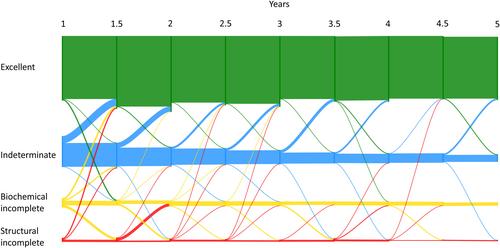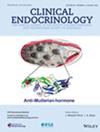Tracking dynamic evolution of low- and intermediate-risk differentiated thyroid cancer: Identification of individuals at risk of recurrence
Abstract
Objective
The generally good prognosis of low- and intermediate-risk differentiated thyroid cancer (DTC) underscored the need to identify those few patients who relapse.
Design
Records of 299 low- or intermediate-risk DTC patients (mean follow-up 8.2 ± 6.2 years) were retrospectively reviewed. The sample was classified following the American Thyroid Association (ATA) dynamic risk stratification (DRS) system.
Patients and Measurement
After classifying patients according to DRS at the first visit following initial therapy (FU1), structural recurrence occurred in 2/181 (1.1%), 5/81 (6.2%) and 13/26 (50.0%) with excellent, indeterminate and biochemical incomplete response to treatment, respectively. All relapses but one happened within 5 years from FU1. Univariate analysis comparing excellent, indeterminate and biochemical incomplete with structural incomplete responses at the end of the follow-up, identified tumour size (p < .001), T status (<0.001), positive lymph nodes (N) (p < .01), multifocality (p < .004), need of additional radioactive iodine (RAI) (p < .0001) and first DRS status (p < .0003) as risk factors of recurrence. In the multivariate analysis, only RAI remained statistically significant (p < .02). Comparison between excellent and indeterminate with biochemical and structural incomplete responses, identified tumour size (p < .0004), T (p < .01), N (p < .0001), bilaterality (p < .03), first DRS status (p < .0001) and RAI (p < .001) as recurrence risk factors. T (p < .01) and first DRS (p < .0006) were confirmed in the multivariate analysis.
Conclusions
Patients with DTC classified as low- or intermediate-risk of recurrence with excellent response to treatment at FU1 rarely develop structural disease and this occurs almost exclusively in the first 5 years. Initial DRS status is an accurate tool for determining the risk of recurrence.


| 公司名称 | 产品信息 | 采购帮参考价格 |
|---|
 求助内容:
求助内容: 应助结果提醒方式:
应助结果提醒方式:


